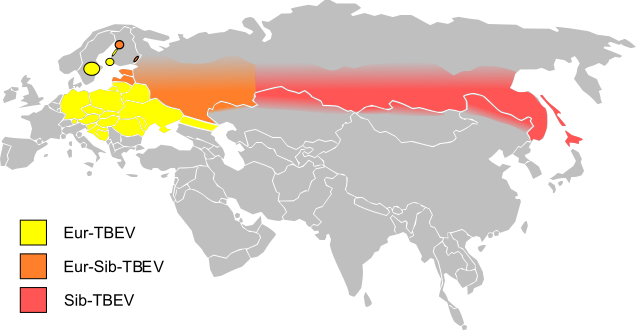Tick-borne encephalitis epidemiology and demographics
|
Tick-borne encephalitis Microchapters |
|
Diagnosis |
|---|
|
Treatment |
|
Case Studies |
|
Tick-borne encephalitis epidemiology and demographics On the Web |
|
American Roentgen Ray Society Images of Tick-borne encephalitis epidemiology and demographics |
|
FDA on Tick-borne encephalitis epidemiology and demographics |
|
CDC on Tick-borne encephalitis epidemiology and demographics |
|
Tick-borne encephalitis epidemiology and demographics in the news |
|
Blogs on Tick-borne encephalitis epidemiology and demographics |
|
Risk calculators and risk factors for Tick-borne encephalitis epidemiology and demographics |
Editor-In-Chief: C. Michael Gibson, M.S., M.D. [1] Associate Editor(s)-in-Chief: Ilan Dock, B.S.
Overview
Tick-borne encephalitis is endemic to regions within Europe and Asia. These areas include territories spanning from France to Northern Japan; and from Russia to Albania. Incidence is approximately 5,000 to 13,000 infections per year. Vaccination is a method of preventing the virus, however the virus will still persist at 1 case per 10,000 unvaccinated individuals. The majority of infections occur between April and November with the highest rates of infection in the early and late summer periods. There is a higher incidence of infection among individuals above the age of 50.
Epidemiology and Demographics
Endemic Regions
- Located primarily in areas of Europe and Asia.
- From eastern France to Northern Japan, from northern Russia to Albania.
- European countries reporting tick-borne encephilitis infections include: Siberia, Baltic states, Albania, Austria, Belarus, Bosnia, Croatia, Czech Republic, Denmark, Finland, France, Germany, Hungary, Italy, Norway, Poland, Romania ,Serbia, Slovakia, Slovenia, Sweden, Switzerland, and Ukraine.
- Asian countries reporting tick-borne encephilitis infections include: China, Japan, Kazakhstan, Mongolia, and South Korea.[1]

Incidence
- 5,000 to 13,000 tick-borne encephilitis infections are reported each year.
- Overall risk for an unvaccinated individuals living within endemic regions is approximately 1 case per 10,000 people. [1]
- Russia and Europe report between 10-12,000 human cases annually.[2]
Seasonal Distribution
- Majority of cases occur between April and November.
- Peak activity rates have been reported during early and late summer.[1]
Age
- Peak levels of incidence, as well as severity, are reported within individuals over the age of 50 years.[1]
References
- ↑ 1.0 1.1 1.2 1.3 Centers for Disease Control and Prevention Yellowbook. http://wwwnc.cdc.gov/travel/yellowbook/2016/infectious-diseases-related-to-travel/tickborne-encephalitis. Accessed February 3rd, 2016.
- ↑ Tick-borne encephalopathies : epidemiology, diagnosis, treatment and prevention. Günther G, Haglund M (2005). "Tick-borne encephalopathies : epidemiology, diagnosis, treatment and prevention". CNS Drugs. 19 (12): 1009–32. PMID 16332143.